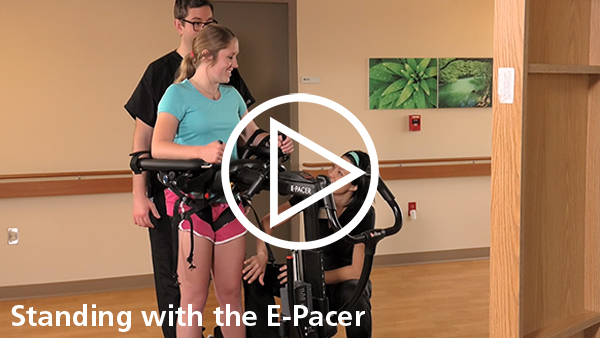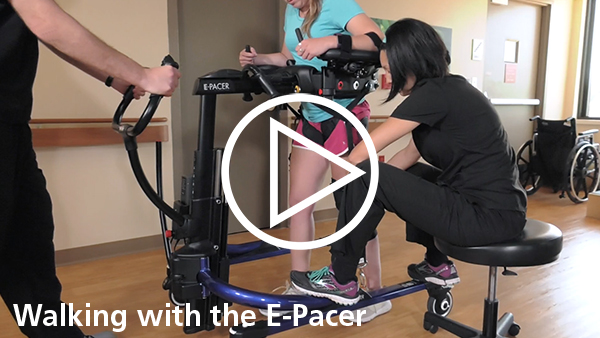


Individuals hospitalized due to stroke or brain injury have one over-arching goal: to return home and into the community again. Unfortunately, many individuals with lasting debility require placement in long-term care or assisted living instead. This isolation and loss of independence can be devastating to patients and families. Because independent walking is a primary predictor of whether a patient can safely return home, it’s not surprising that patients work hard to achieve improved mobility in their inpatient therapy sessions.1-6 Despite these efforts, those that do go home still experience difficulty walking that affects independence and quality of life.6-10
Recent assimilation of research, motor learning theory, and technology into rehabilitation is rapidly improving the prospects of those going home, with notable improvements in mobility outcomes.
Motor Learning and Unweighted Gait Intervention
Body weight support gait training, whether on a treadmill or over-ground, provides an optimal environment for motor learning, as it is intensive, repetitive and task-specific.11-13 Solid evidence describes such interventions helping patients achieve increased gait speed, symmetry, trunk control, balance and upright posture.2,3,6,7,9,10,12,14-17
Traditional therapy focuses on regaining trunk control and sitting balance before standing and gait. When gait training begins, it is in parallel bars or with a walker. Knee buckling, foot drag, and fatigue can make a patient fearful of falling. The therapist also cannot facilitate proper leg movement because they are guarding the patient. Because of these issues, distance is limited. In body-weight support systems, however, patients are up and walking earlier with less cardiac demand and fatigue, thus gaining additional practice time and higher step repetitions.9,12,13,18 In the first 14 days post stroke, patients who were upright and walking for 10 minutes at least twice a day, demonstrated higher rates of return to independent walking and shorter rehabilitation stays compared to controls receiving standard stroke care.5 Further, patients who performed unweighted ambulation walked with a higher quality gait pattern and developed less compensatory gait deviations.1,2,9,14,15,17 This means they demonstrated increased hip extension and strength, decreased hip flexor patterning and foot drop: common problems associated with the functional deficits and gait deviations noted in patients who went home after conventional therapy interventions.1,6,14,10,16
Gait Technology – the Pros and Cons
Unweighted gait training devices frequently utilized in rehab facilities range from body weight supported treadmills (Biodex) to robotic devices (Lokomat) and ceiling harnesses (Zero-G). These provide the necessary unweighting and support features to meet ambulation and motor learning goals. However, because of the complexity of these larger devices, therapists must undergo extensive training and practice in order to use them safely and effectively with a patient.19 Newer staff or resource staff members may not have the experience to follow the plan of care.
With rising healthcare costs and decreased insurance reimbursement, many rehabilitation facilities are unable to afford these systems, which can cost between $30,000 and $200,000. Robotic systems and ceiling tracks are the most expensive, often prohibitively so. With ceiling track systems, it is also difficult for a therapist to move with the patient as they advance down the track, making it a challenge to facilitate movement of the weaker limb. While somewhat more affordable, treadmill gait training does not allow a patient to practice turning, a necessary intervention for fall prevention and gait recovery.13,21 Body weight support treadmill training is also physically taxing for a therapist, and can cause fatigue, muscle soreness or work-related repetitive injury to the therapists themselves.20 Set-up and take-down time on a relatively dependent patient can significantly cut into the actual time that a patient is up and walking.
This is why over-ground gait devices are catching attention in rehab facilities across the county.
Revolutionizing Gait Rehab with the E-Pacer
The E-Pacer, a supportive over-ground walking device, takes gait intervention a step further, allowing clinicians to better meet the recommendations in the literature. With a lightweight frame, easily adjustable supports and electric sit-to-stand assistance, set-up is a snap. Patients are up and walking quickly and safely, giving more time in practice and more step repetitions. Studies done with BWSTT recommend a patient should ambulate over 1,000 steps in 20 minutes to improve outcomes.1 In the E-Pacer, because set-up is quick and simple, a patient can easily cover 1,500 steps in a session.
The E-Pacer wheels, designed specifically for ambulation, allow the patient to walk anywhere in the facility. It allows the patient to speed up as they progress or slow down as they fatigue. This includes the option to side step, step backwards, turn or practice dynamic functional reaching. With the E-Pacer in the posterior position, further intensity and variability can be included in the gait training session. Patients prefer the Rifton E-Pacer for its comfort and control of pace and stepping.
Therapists appreciate the ease of use and capacity to have their patients walking greater distances and making rapid improvements in gait recovery so they can return home quickly and with good functional abilities. A therapist sitting on a rolling stool, with their feet resting on the frame of the E-Pacer, is in an ideal ergonomic position to help the patient to advance their weaker limb, facilitating dorsiflexion, hip flexion, and knee extension to overcome drop-foot and knee buckling.
Because the Rifton E-Pacer can be purchased for under $6,000.00, it makes unweighted gait training affordable for many facilities that may not have the budget for a more expensive device. This ensures appropriate access to care, keeps practice current and evidence-based, and helps facilities best serve their adult neuro populations with state-of-the-art, competitive treatment options.
Back to Top